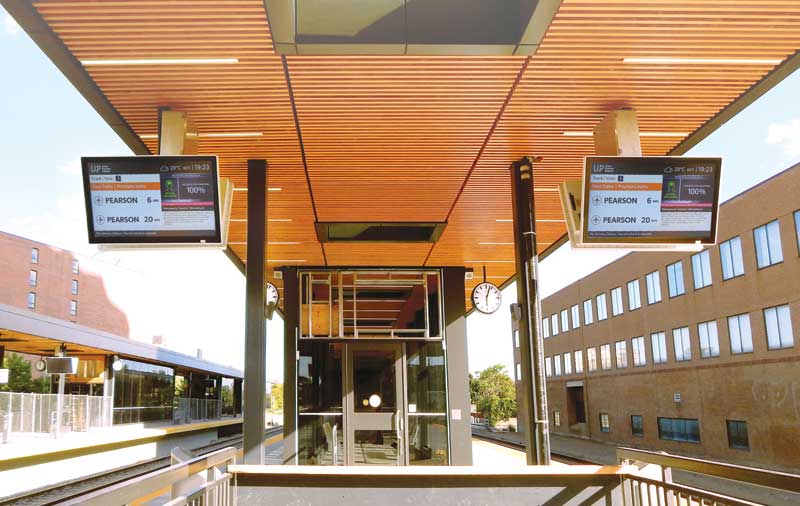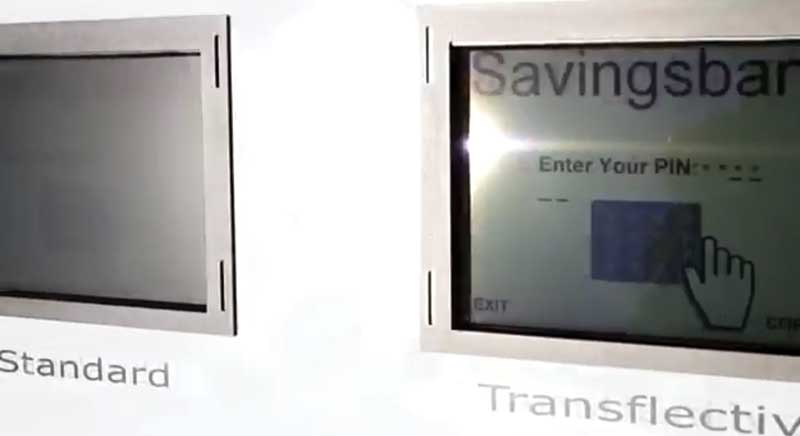Digital Signage: Ensuring outdoor readability
by all | 31 May 2016 9:16 am

Photos courtesy Nanov Display
By Myung Kune Moon
Outdoor digital signage deployments face many challenges from the elements, particularly in Canadian climates. Screens must be kept watertight to prevent damage by rain and snow. Systems need to be able to operate continuously at extreme temperatures, from cold winters to hot summers. They need to be protected against dirt, brake dust, fumes and other airborne particles. Depending on their location, they must be engineered to sustain local wind loads, including hurricane levels in coastal regions. And they must address the threat of vandalism.
One particular ongoing challenge, however, is ensuring outdoor digital signs can be easily read by passersby. Among the elements, the main threat to readability is direct sunshine. There are several ways to make sure liquid crystal displays (LCDs) remain readable under sunny conditions, including: increasing brightness with light-emitting diode (LED) backlighting units (BLUs); optical bonding of the panel to glass; and placing a transflective film behind the panel.
Transmissive, reflective and transflective
The most common indoor digital signs are transmissive LCDs, which are installed with BLUs as their light source and do not use any reflective film behind their panels. So long as ambient light sources are not as strong as the BLUs, these screens can be seen well. This means they are readable in areas with little light or in complete darkness. Outdoors, however, daylight is stronger than the BLUs, so it is no longer possible to clearly see this type of screen’s content.
There are also reflective LCDs, where a reflective film is placed behind the screen, with no BLUs. These screens are only visible with the help of ambient light, whether from the sun or from other lamps. And in darkness, they are not readable at all.
To gain the benefits and to avoid the drawbacks of both transmissive and reflective LCDs, another option is to place a transflective film behind the screen, which cannot be permeated by light from the front, but allows light from the back to enter cleanly. In this way, a digital sign can be seen clearly under bright outdoor conditions, but will also reproduce its content’s colours naturally and remain highly bright at night or other under dark conditions (e.g. cloud cover).
Transflective films have been shown to optically increase screen brightness by 30 per cent. An anti-reflection coating reduces glare on the surface. And perhaps most effectively of all, transflective film actually ‘recycles’ sunlight, by reflecting it from inside the panel so as to reuse it as a backlighting source. Thus, when sunlight becomes stronger, the panel actually becomes brighter.

Recent research and development (R&D) of transflective films have yielded more easily legible displays.
Pros and cons
There are advantages and disadvantages to the different measures that can be taken to make LCDs more clearly readable outdoors.
Increasing the brightness of an LCD’s BLUs and adding a transflective film during the manufacturing process will both mean increases in costs. Moreover, transflective films can be difficult (a) to source and (b) to place behind the LCD panel. A class 100 clean room is recommended for this process.
That said, numerous sunlight readability tests with various films, panel sizes and installation positions have helped technicians achieve optimum visibility for mass-produced large-format LCDs, including units that have already performed well in Canadian weather conditions.
One advantage of creating a transflective LCD over adding moer LED BLUs is energy efficiency. For heat management purposes, LEDs need to be kept cool through the use of fans, which consume electricity. A transflective film means less cooling is needed and, thus, less energy is consumed.
There are also savings in weight. A transflective LCD is lighter than comparable outdoor screens and therefore more easily portable.

Toronto’s new Union Pearson (UP) Express train line displays information on 1 to 1.4-m (42 to 55-in.) transflective digital signs to ensure they can be read in sunny conditions.
Avoiding screen blotches
Under direct sunlight, the liquid crystals in a display will undergo ‘phase changes’ if there is a dramatic increase in the panel’s surface temperature. Black blotches will appear on the screen when this surface temperature reaches 60 C (140 F).
To prevent any such ‘solar blackening’ symptoms, outdoor digital signage systems should use in-plane-switch panels, which offer an internal temperature tolerance of 110 C (230 F). In addition, fans and blowers should be used to circulate the air and maintain the internal monitor temperature at a maximum of 60 C. This will facilitate the proper functioning of the electronic components inside the displays, including embedded computers, Universal Serial Bus (USB) modules and Analogue to Digital (AD) converters.
The right type of watertight
As mentioned, it is important to seal an outdoor display against exterior moisture, but this can also lead to an internal buildup of heat. To prevent too much heat from accumulating, one option is to use a ‘heat pipe’ and thermoelectric technology to transfer the interior heat to the exterior through an aluminum surface. This has proven effective in transflective LCDs.
In situations where more LED BLUs are deployed, however, there is a need for stronger measures for heat dissipation, such as ventilation systems that can blow air between the protective glass and the LCD panel, using input and output connectors that have been tested for ingress protection (IP). With the exception of air exhaust holes and strategic air inflow, the panels can still be completely and tightly sealed.
Myung Kune Moon is executive vice-president (EVP) of Nanov Display, which manufactures LCDs for indoor and outdoor digital signage networks. For more information, visit www.nanovdisplay.com[1].
- www.nanovdisplay.com: http://www.nanovdisplay.com
Source URL: https://www.signmedia.ca/digital-signage-ensuring-outdoor-readability/